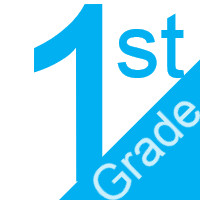1st Grade English
 Standards Glossaries
Standards Glossaries
| K Grade English | 1st Grade English | 2nd Grade English |
 Standards Glossaries
Standards Glossaries
| 3rd Grade English | 4th Grade English | 5th Grade English |
 Standards Glossaries
Standards Glossaries
| 6th Grade English | 7th Grade English | 8th Grade English |
 Standards Glossaries
Standards Glossaries
| 9th Grade English | 10th Grade English | 11th Grade English | 12th Grade English |
 Standards Glossaries
Standards Glossaries
| HS Journalism | HS Speech |
| (L) Language |
ELA-01.LNarrative for the Language Strand:As they move through formal schooling, students must gain control over the many conventions of standard English grammar, usage, and mechanics. They must also learn various ways to convey meaning effectively. Language standards include the rules of standard
written and spoken English as well as the use of language as craft and informed choice among alternatives. The vocabulary standards focus on understanding words and phrases (their relationships and nuances) and acquiring new academic and domain-specific
vocabulary.
First grade students continue learn to write upper and lower case letters and when to use capital letters in writing. They also learn about how to use basic punctuation marks, and how to use singular and plural nouns, and verbs in the past, present and future tense.
How to help your child with the standards in the Language Strand:
Resources
Calculation Method for StrandsStrands are larger groups of related standards. The Strand Grade is a calculation of all the related standards. Click on the standard name below each strand to access the learning targets and proficiency scales for each strand's related standards. | |
ELA-01.L.02ELA-01.L.02 Demonstrate command of the conventions of standard English capitalization, punctuation, and spelling when writing.Sub-Standards:
Introduce:
a. Capitalize dates and names of people.
b. Use commas in dates and to separate single words in a series. c. Capitalize holidays, product names, and geographic names. d. Use commas in greetings and closings of letters. e. Use an apostrophe to form contractions and frequently occurring possessives. f. Generalize learned spelling patterns when writing words (e.g., cage → badge; boy → boil). g. Capitalize important words in titles. h. Form and use possessives. i. Add prefixes and suffixes to base words (e.g., sitting, smiled, cries, happiness). j. Use punctuation to separate items in a series.
Practice:
k. Use end punctuation for sentences.
l. Use conventional spelling for words with common spelling patterns and for frequently occurring irregular words. m. Spell untaught words phonetically, drawing on phonemic awareness and spelling conventions. n. Use conventional spelling for high-frequency and other studied words. o. Spell grade-appropriate words correctly, consulting references as needed and/or using spelling patterns and generalizations. (e.g., word families, position-based spelling, syllable patterns, ending rules, meaningful word parts)
Display proficiency in:
p. Recognize and name end punctuation.
| |
ELA-01.L.03 | |
ELA-01.L.04ELA-01.L.04 Determine or clarify the meaning of unknown and multiple meaning words and phrases based on grade 1 reading and content, choosing flexibly from an array of strategies.Sub-Standards:
a. Use sentence-level context as a clue to the meaning of a word or phrase.
b. Use frequently occurring affixes as a clue to the meaning of a word.
c. Identify frequently occurring root words (e.g., look) and their inflectional forms (e.g., looked, looking).
Student Learning Targets:Knowledge Targets
Reasoning Targets
Skills (Performance) Targets
Proficiency ScaleThe Student Will ...1 Beginning... with help, demonstrates a partial understanding of some of the simpler details and processes (Score 2.0 content) and some of the more complex ideas and processes (Score 3.0 content).Start 2 Developing... demonstrates no major errors or omissions regarding the simpler details and processes but exhibits major errors or omissions regarding the more complex ideas and processes (Score 3.0 content).Simple 3 Proficient“The Standard.”... demonstrates no major errors or omissions regarding any of the information and processes that were end of instruction expectations. Target 4 Advanced... demonstrates in-depth inferences and applications regarding more complex material that go beyond end of instruction expectations.Complex ResourcesVocabulary
Websites
| |||
ELA-01.L.05ELA-01.L.05 With guidance and support from adults, demonstrate understanding of word relationships and nuances in word meanings.Sub-Standards:
a. Sort words into categories (e.g., colors, clothing) to gain a sense of the concepts the categories represent.
b. Define words by category and by one or more key attributes (e.g., a duck is a bird that swims; a tiger is a large cat with stripes).
c. Identify real-life connections between words and their use (e.g., note places at home that are cozy).
d. Distinguish shades of meaning among verbs differing in manner (e.g., look, peek, glance, stare, glare, scowl) and defining or choosing them or by acting out the meanings. Student Learning Targets:Knowledge Targets
Reasoning Targets
Skills (Performance) Targets
Proficiency ScaleThe Student Will ...1 Beginning... with help, demonstrates a partial understanding of some of the simpler details and processes (Score 2.0 content) and some of the more complex ideas and processes (Score 3.0 content).Start 2 Developing... demonstrates no major errors or omissions regarding the simpler details and processes but exhibits major errors or omissions regarding the more complex ideas and processes (Score 3.0 content).Simple 3 Proficient“The Standard.”... demonstrates no major errors or omissions regarding any of the information and processes that were end of instruction expectations. Target 4 Advanced... demonstrates in-depth inferences and applications regarding more complex material that go beyond end of instruction expectations.Complex ResourcesVocabulary
Websites
| |||
ELA-01.L.06ELA-01.L.06 Use words and phrases acquired through conversations, reading, being read to, and responding to texts, including using frequently occurring conjunctions to signal simple relationships (e.g., because).Student Learning Targets:Knowledge Targets
Reasoning Targets
Skills (Performance) Targets
Proficiency ScaleThe Student Will ...1 Beginning... with help, demonstrates a partial understanding of some of the simpler details and processes (Score 2.0 content) and some of the more complex ideas and processes (Score 3.0 content).Start 2 Developing... demonstrates no major errors or omissions regarding the simpler details and processes but exhibits major errors or omissions regarding the more complex ideas and processes (Score 3.0 content).Simple 3 Proficient“The Standard.”... demonstrates no major errors or omissions regarding any of the information and processes that were end of instruction expectations. Target 4 Advanced... demonstrates in-depth inferences and applications regarding more complex material that go beyond end of instruction expectations.Complex ResourcesVocabulary
Websites
| |||



 Grade 1
Grade 1